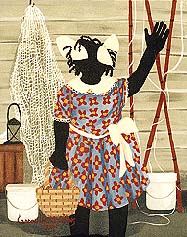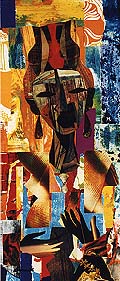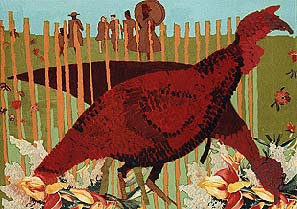

August Issue 2001
Red Piano Too Art Gallery on St. Helena Island, SC, Presents Fifth Annual Southern Summer Show
Every human being is a member of .the human
family regardless of differences in religion, culture, color and
creed. Deep down, there is no difference.
-The Dalai Lama
The Red Piano Too Art Gallery on St. Helena Island, SC, moved down the road a ways last August to the intersection of Martin Luther King Drive and US Highway 21, known locally as Sea Island Parkway on St. Helena Island, just outside of Beaufort, SC. The gallery's presence enriches the commerce in art and ideas at the historic Corner Community, a good reason to visit any time or to attend the Fifth Annual Southern Summer Show to be held Aug. 4, from noon to 4pm. Works by participating artists will continue to be showcased during the remainder of the month of Aug. Alla We Da One, the hallmark of Red Piano Too Art Gallery, will be the theme of the Fifth Annual Southern Summer Show. The afternoon festivities are free and open to the public.
As part of the afternoon's festivities, many of the 100 artists whose works are displayed at the gallery will be on hand. A few, like Allen Fireall will be painting on the porch or around the gallery. Jeannette Lee will demonstrate the art of sewing sweetgrass baskets. Luke Smalls the art of making a shrimp cast net. The rich harmonies of a traditional church choir will fill the air, while visitors enjoy the country store setting with a porch swing, a bubble machine, snow cones and the possible excitement of an entertainment icon sighting.
Gallery owners Mary Mack and Elayne Scott are putting out the welcome mat and extending a heartfelt Gullah greeting to longtime residents and newcomers alike, Alla we da one. This down-home affirmation, usually accompanied with a warm embrace, is universally recognized by peoples from Africa to the Americas and is the hallmark of the gallery owners' philosophy and approach to presenting art, history and culture.
Scott recalls her years in the Caribbean and a conversation with a colleague when they were starting a school and the first children's library in the country of St. Vincent. They were watching news about Apartheid in South Africa. "We said to each other, if only we could export the Rastafarian concept of 'One Love', what a benefit it would be to everyone in the world." Scott was bound to bring back to South Carolina all she had learned from living in the Caribbean. The Red Piano Too Art Gallery became her way of connecting with, and advocating for, the Gullah people and the art of those who seek to bring unity to the world.
Martin Luther King adroitly illuminated the dilemma of racial and class separatism in a message that remains relevant today. It is handwritten on a door in the gallery, "...They don't know each other because they can't communicate with each other." Mack and Scott have made it their business to open communication between people of different cultures and to encourage the understanding that comes from association and dialog. Each of the artists showing their work at the gallery has a story to tell through their art that on some level grapples with the human condition.
Art sometimes comes to us through the back door, as Benton Lutz discovered. A few years ago he found himself taking up a brush and leftover house paint to capture a moment he couldn't put into writing - the choreography and color of three young girls, skirts dancing, skipping across the street. Lutz had written two novels, thousands of poems and hundreds of short stories. He had been a minister for 20 years and had become a psychotherapist who consults with hospitals to help build stronger, more effective care-giving teams. His career as a visual artist started in 1997 when the Red Piano Too Art Gallery hung and sold that first painting and his wife said, "That's good Benton, we need to get you some paints."
When asked to do a rendition of Red Piano Too for the Fifth Annual Southern Summer Show Benton Lutz's interpretation was shaped not by the building's exterior, but by the street sign for the intersection of Martin Luther King Drive and Sea Island Parkway. Here were the crossroads that connect the Sea Islands to the mainland, a symbol of the progression of Africans and Europeans in the Americas akin to the Trail of Tears. Past and present travel these roads, the horrors and sorrow of separatism-enslavement and exploitation-as well as the unifying and joyful hustle and bustle of local commerce and recreation. To convey the show's theme Alla we da one, Lutz painted a playful Bourbon Street at the Corners Community and titled it Red, Yellow, Black and White, in reference to the song many children learn in Bible school.
Lutz plays with symbols. He incorporates his poetry in a paper maché mountain range. He takes pictures of incongruities he might want to use in a painting like a cemetery with a playground in the background. Recently he began making memorabilia collages of stuff from the attic. In a six-part series, Lutz replicates his son Will's childhood drawings, which he makes into father-son decoupages. "Will taught me how to see like a child."
That innocent eye brings a comic touch to almost everything Lutz creates. Take his nudes: Mermaid with Mermaid Cat and Mermaid Bird; Nude Behind a Picket Fence, Palmetto Palm Behind a Picket Fence; and Nude Angle. He removes the prohibitive sting of sexuality and flings subject and viewer into another world.
Lutz believes that we are all looking for something that touches the soul. "Folk art usually doesn't make a pronouncement about itself. It's out there without pretensions. If an image speaks to you, it goes to the soul where religion resides, there is no orthodoxy. If you see something, fine; if not, walk away."
Sabra Jean Wolfe has always has the capacity to reassess and apply her creativity in a new vein. Right now she works on the gallery floor, assisting customers and answering phones in her charming Southern way. Sometimes she cheerfully answers the phone, "Two Red Pianos, may I help you?" At home she works in her Coosaw Island studio with a dirt floor. Vincent Van Gogh was her earliest inspiration.
In the 1980s and 90s, Wolfe was a successful jewelry maker, selling at the gallery, through Pixie Products in Lobeco and to shows around the Southeast. When working with porcelain caused damage to her eyes, she started doing watercolors and then switched to oils.
An exposure to Sam Doyle's primitive paintings of the Gullah experience from bondage to modern life inspired Wolfe to change mediums again. Doyle's painting of an enslaved African in chains, back bleeding from a lashing, profoundly touched her. Wolfe wanted to capture the visceral energy and the sense of going back in time Doyle achieved by painting on old roofing tin. With a pair of tin snips she cut out a rooster and painted it. As she recalls, almost with disbelief, "It came out really good." Over the years she has created a virtual Noah's Ark of birds, fish, crabs and flowers, each a remembrance of rural Sea Island life.
 Cassandra Gillens
Cassandra Gillens
Cassandra Gillens' paintings emanate from a
deep spirituality and desire to please others. Like Jonathan Green,
she respectfully observes her subjects and paints iconic tableaux
that depict the day-to-day pursuits of family and community life.
She calls her paintings "visions of culture".
"I might think of something I saw long ago or what older
folks talk about when I'm sitting with them on the porch. It gets
in my head and I hold it there until I am ready to paint it."
She mentions, "The Friendliness of Down South: Hello, St.
Helena", a recent painting of a porch scene with a girl waving
at you. Sometimes Gillens paints "off canvas" such as
the time she painted the Serenity Prayer on a smooth bare
scar of a large water oak in her yard.
Gillens paints religiously, almost daily from 7am until 5pm. At any one time she will have about 50 paintings in her head and will have sketched five or six. On trips out of town she carries envelopes and a pencil to sketch images that come to her.
Her one hope is to leave a mark on history, a cultural remembrance of ways of the Gullah, of what used to be and may not be carried on or done in the same way, like crabbing, shrimp net casting, dock fishing and quilting.
 James
Denmark
James
Denmark
It took about 40 years for James Denmark to become one of the lucky ones whose marriage brought him to live in the Lowcountry near Yemassee, SC. He married the girl next to him in the registration line at Florida A&M in Tallahassee, where he studied fine arts on a sports scholarship in the 1950s. She was a native of Beaufort, SC, who grew up on East Street. His family boasted generations of artists, traditions of sculpture, quilt making, masonry and design, creative expressions he would later assimilate in his collages and woodcuts.
At FA&MU noted art historian and painter Dr. Samella Lewis introduced Denmark to the rich history of the influences of African art on European art and the Harlem Renaissance. New York City became home for 38 years where he attended Pratt Institute of Fine Arts and moved comfortably in the New York art community. Denmark took advantage of opportunities to see new works by the abstract expressionists like Jackson Pollock and William deKooning. He sought out African American masters and giants of the Harlem Renaissance who could guide him: Jacob Lawrence, Ernest Crichlow, Romare Bearden and Norman Lewis. Recognizing Denmark's gifts they mentored him and allowed him to visit their studios. The result was a successful New York career with many shows and sales to collectors such as Oprah Winfrey and the Metropolitan Museum of Art.
Coming to the Lowcountry is an exciting new beginning - building a new home and studio - living close to nature, exploring the marshes, fields and woods. "I see so much originality, people with beautiful accents, a way of life that is void of over sophistication. My eyes gobble up everything." Denmark has only been living in Yamassee a few months, although over the years he and his wife have traveled back and forth for short stays, his Lowcountry-inspired collages in open edition prints include, Old Fashioned Get Together, Friendship and Now Generation.
Denmark is already working from an outdoor
tent studio with some tables, incorporating his new world in his
art.
 Susan McLendon
Susan McLendon
Gutsy and empathic, Susan McLendon lived and painted in Tanzania, Malawi, Grenada and Guatemala for ten years before returning home to the South Carolina Lowcountry in the early 1990s. Her vibrant paintings are a life-affirming compliment to her ophthalmologist husband's dedication to providing eye care, often in remote areas where healthcare is not readily available.
McLendon asserts that the Gullah men and women of Beaufort County have much to share with all people. She laments the dissolution of their rich culture and warns against letting this continue. Her Endangered Species series eloquently portrays the grace and beauty of a people who live in harmony with creatures of nature that others consider expendable.
On her website (www.postcardpaintings.com) she shares her world view and her appreciation of the values and lifestyles of people who have not become caught up in fast-paced modern life. "We are all little people in a big landscape. People in developing countries are one with their surroundings. They move to the rhythm of the universe. Where time moves slower and people have fewer possessions, they are listening to the universe, and we can learn from them."
McLendon's untitled paintings of women with rakes on the tree-lined road at Coffin Point and women and men "in their element" remind us that we are all peers, working side-by-side on earth. Her paintings acknowledge what most historians have ignored - since their arrival from Africa in the early years of South Carolina, the Gullah have built the historic buildings, developed the technology to grow the crops, and harvested the fields and salt marshes.
It is precisely what these and other artists see and express in their individuality that moves Scott and Mack to ask that we all search our hearts to understand why we have come to the South Carolina Lowcountry. "If we want to keep things we all value, we need to find different ways of looking," explains Mack. "Even in our differences we need to come together. Alla we da one."
Red Piano Too gallery shows work by more than
100 Southern Outsider, self-taught, folk and fine artists.
For more information check our SC Commercial Gallery listings
or call the gallery at 843/838-2241, e-mail at (redpianotoo@islc.net)
or on the web at (http://wwww.redpianotoo.com).
Mailing Address: Carolina Arts, P.O. Drawer
427, Bonneau, SC 29431
Telephone, Answering Machine and FAX: 843/825-3408
E-Mail: carolinart@aol.com
Subscriptions are available for $18 a year.
Carolina Arts
is published monthly by Shoestring
Publishing Company, a subsidiary of PSMG, Inc.
Copyright© 2001 by PSMG, Inc., which published Charleston
Arts from July 1987 - Dec. 1994 and South Carolina Arts
from Jan. 1995 - Dec. 1996. It also publishes Carolina Arts
Online, Copyright© 2001 by PSMG, Inc. All rights reserved
by PSMG, Inc. or by the authors of articles. Reproduction or use
without written permission is strictly prohibited. Carolina
Arts is available throughout North & South Carolina.